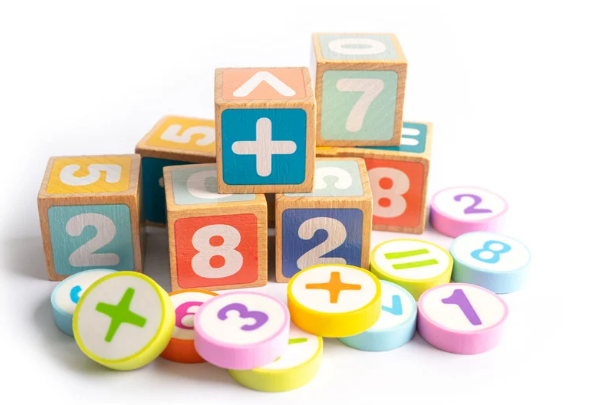MATH IN THE BEGINNING YEARS

Teaching math at home doesn’t require special skills it just needs a little creativity. When toddlers count their toys, notice shapes in their room, or sort fruits in a basket, they’re already learning math in the most meaningful way.
Math is all around us even before children see numbers in their books! Toddlers begin to understand math concepts naturally when they play, explore, and interact with the world. As parents, you don’t need fancy tools or workbooks to introduce math. Everyday household objects are enough to build early math skills in a fun and stress free way.
Why Early Math Matters
Early math activities help toddlers:
Develop problem solving skills.
Build logical thinking.
Understand numbers, shapes, and patterns in daily life.
Prepare for formal learning in preschool and kindergarten.
The best part? Math can be taught during playtime, mealtime, or even while getting dressed!
Simple Ways to Teach Math at Home
1. Counting with Toys and Objects
Use blocks, spoons, or cars to practice counting. For example, “Let’s put 3 cars in the garage,” or “Can you give me 2 spoons?”
This builds one-to-one correspondence (matching one object to one number).
2. Sorting and Classifying
Ask your child to sort laundry (socks vs. T-shirts), vegetables (tomatoes vs. potatoes), or toys (soft vs. hard).
Sorting develops early logical thinking and the ability to compare attributes.
3. Shapes in the House
Look for shapes in everyday objects: plates (circle), doors (rectangle), tiles (square), pizza slices (triangle).
Helps children recognize geometry in real life.
4. Patterns with Food
Make simple patterns with fruits or snacks: apple–banana–apple–banana, or biscuit–cracker–biscuit.
Ask your toddler to continue the pattern.
Builds sequencing and prediction skills.
5. Comparisons (Big–Small, Tall–Short)
Compare water bottles, shoes, or pillows. Ask: “Which one is bigger? Which is heavier?”
Develops measurement concepts.
6. Position and Direction
Play hide-and-seek with toys. Place a teddy on the bed, under the chair, next to the table, and name the position.
Strengthens spatial awareness.
7. Everyday Counting Opportunities
Count steps while climbing stairs, count chapatis on the plate, or count claps while singing a rhyme.
Reinforces number sense in natural settings.
Make It Fun and Playful
Use songs and rhymes for numbers.
Allow toddlers to touch and play with objects instead of just watching.
Don’t rush math at this stage is about exploration, not memorization.
Here’s a list of premath concepts to start with along with brief descriptions, followed by an outline of a Kindergarten syllabus:
Pre-Math Concepts for Kindergarten
Sorting & Classifying
Grouping objects based on color, shape, size, or type.
Example: Putting all red blocks together, or sorting buttons by size.
Matching
Recognizing similar items and pairing them.
Example: Matching socks, shapes, or pictures.
Comparisons (Big vs Small, Tall vs Short, etc.)
Learning about attributes by comparing two or more objects.
Example: Taller tree, shorter pencil.
Opposites
Understanding contrasting concepts.
Example: Hot/cold, heavy/light, full/empty.
Patterns & Sequencing
Identifying and continuing simple patterns (AB, ABB, ABC).
Example: Red-blue-red-blue or arranging beads in order.
Spatial Concepts (Position & Direction)
Understanding where things are located.
Example: Above/below, inside/outside, left/right.
One-to-One Correspondence
Matching one object to one number/thing.
Example: One plate for one spoon, one child for one chair.
Counting (Rote & Object Counting)
Saying numbers in order and actually counting objects.
Example: Counting toys or claps.
Number Recognition
Identifying numbers 0–9 and later 10–20.
Example: Spotting numbers on clocks, books, or calendars.
Shapes & Colors
Recognizing and naming basic shapes and primary/secondary colors.
Example: Circle, square, triangle; red, blue, green.
Measurement (Informal)
Comparing objects without standard units.
Example: Long–short, more–less, heavier–lighter.
Time Concepts (Basic)
Understanding daily routines and sequencing of events.
Example: Morning–afternoon–night, days of the week.
Money Concept (Introduction)
Recognizing coins/notes and using them in play.
Example: Pretend shopping.
Kindergarten Math Syllabus (General Framework)
Pre-KG / Nursery
Colors, shapes, and sizes.
Sorting and matching activities.
Counting objects (1–5).
Number recognition (1–5).
Opposites (big–small, hot–cold).
Simple patterns.
Lower KG (LKG / Junior KG)
Number recognition (1–10).
Counting objects (1–10).
One-to-one correspondence.
More/less, tall/short, long/short.
Shapes: circle, square, triangle, rectangle.
Sequencing & simple patterns (AB, AAB).
Position words (in, on, under, left, right).
Upper KG (UKG / Senior KG)
Number recognition (1–20, some up to 50).
Counting objects (1–20).
Before, after, between numbers.
Simple addition & subtraction (with objects or pictures).
Comparing numbers (greater than/less than).
Advanced patterns (ABC, ABB).
Time concepts (day night, days of week).
Introduction to money.
Basic measurement (longer, shorter, heavier, lighter).
Math learning for toddlers is not about worksheets or memorizing numbers, it’s about discovery. Every spoon in the kitchen, block in the toy box, or sock in the laundry basket can become a teaching tool. When parents make math a part of daily conversations and play, children grow up seeing math as something natural and enjoyable, not difficult or scary. By keeping activities hands on and playful, you are laying a strong foundation for a lifelong love of learning.
Hindi
Phonics
- Alphabet worksheets
- Letter Sound Worksheets
- abc Phonic sound activity
- CVC Words List Free Printables
- Short Vowel Sounds
- Phonics Short Vowel a CVC Free Worksheets
- Phonics Short Vowel e CVC Free Worksheets
- Phonics Short Vowel i CVC Free Worksheets
- Phonics Short Vowel o CVC Free Worksheets
- Phonics Short Vowel u CVC Free Worksheets
- Beginning Blends – Letter l Blends
- Beginning Blends – Letter s Blends
- Beginning Blends – Letter R Blends
- Beginning Blends – Letter l Blends Worksheets
- Beginning Blends – Letter S Blends Worksheets
- Beginning Blends – Letter R Blends Worksheets
